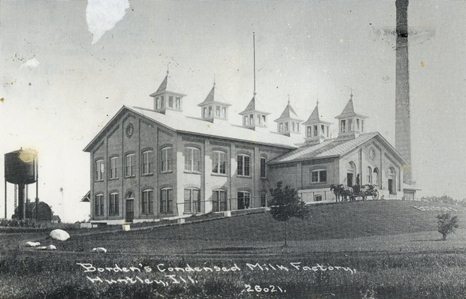Milk Plants and Milk Processing in Huntley
The milk and creamery business in the Huntley area was deemed “An industry upon which much of our present and future prosperity depends” –July 21, 1894 The Huntley News
The first cheese factory was established in 1866 by Messrs. Blanchard and Woodworth on the farm of A. W. Nash on Haligus Road in Section 28 of Grafton Township.
The first milk factory in Huntley was that of Messrs. Wood and Weltzien.

D. E. Wood had several creameries in the area surrounding the village prior to 1873. That year, John G. Weltzien went to work for Mr. Wood. Some two years later, Wood offered Weltzien a partnership in the company and their milk processing plant was moved to a spot along the railroad tracks, becoming the first such plant in the village. The partnership continued until 1883, when Mr. Wood retired. At that time, Mr. Cornell bought into the company. Minnie Weltzien was employed as a bookkeeper for the three creameries owned by her father.
The July 21, 1894 issue of The Huntley News stated: “The Huntley cheese factory owned by Messrs. Weltzien and Cornell is the largest in capacity and output of any in existence. The average receipts of the creamery are not less than ten tons of milk for every day in the year.”
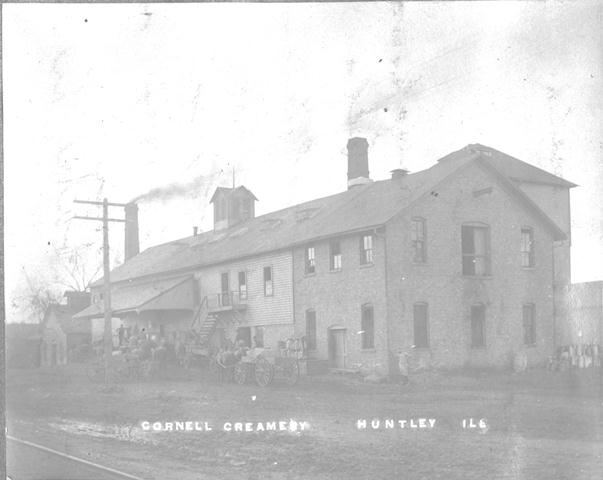

The plant had the latest and most modern milk processing equipment and a unique system of refrigeration. The article stated the factory bought milk on six-month contracts at prices averaging about $1.10 per hundred pounds for the year.
The Huntley News of July 21, 1894 claimed, “Farmers in the district surrounding Huntley produce more milk to the square mile than any other area in the world.”
For this reason, local milk factories grew and prospered.
In May of 1907, the Cornell plant along the west side of the railroad tracks burned to the ground. Cornell Brothers then moved to a brick building along the east side of the railroad tracks. The building most recently was known as Catty Corporation.
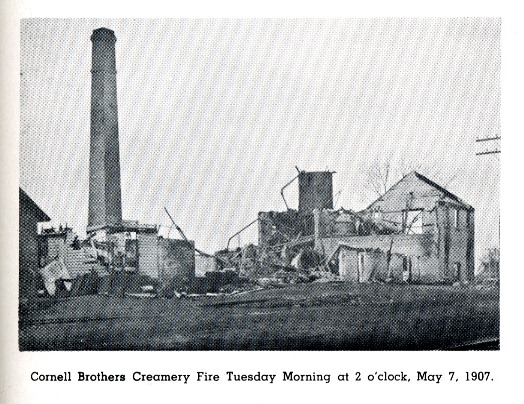
By the end of 1907 three milk factories were in operation in the village–Borden’s, Cornell and Victor Mey.
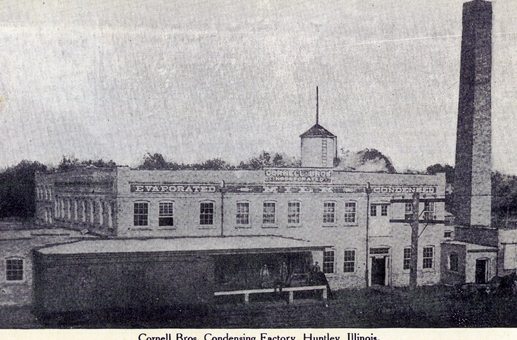
Huntley milk factories moved from location to location around the village through the years. The Jelke Milk Company moved into the Cornell building (Catty) after Cornell moved out around 1920.
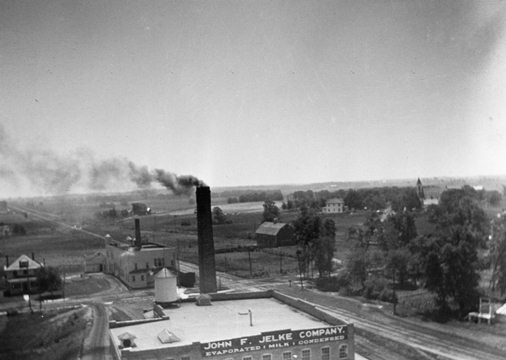
Borden’s built their milk processing plant on Vine Street in 1907, then moved out circa 1920.
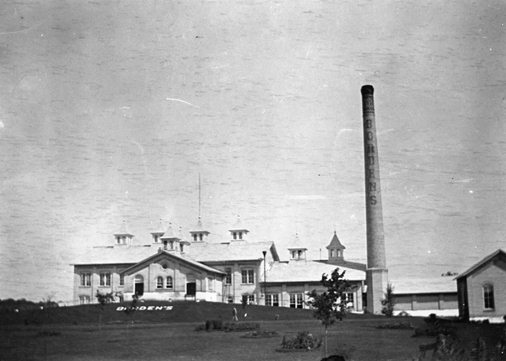
The Lattimer brothers built a mill on Mill Street in the village’s earliest years. The Columbia Creamery company occupied the building when in 1888 C. D. Chase came to manage the creamery company. Chase was a chemist trying to find additional uses for milk besides butter and cheese. The factory also made candy and ice cream.
Columbia Creamery still was in business in Huntley in 1894.
Victor Mey made a deal with Lattimer brothers to turn the Mill Street building into a milk bottling plant in 1907. (See article below)

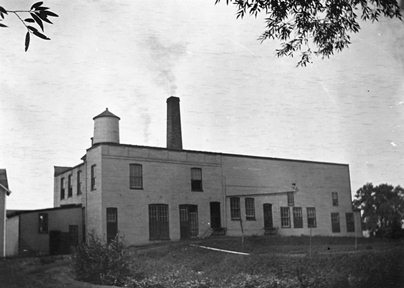
The Victor Mey plant had the first electric service in Huntley. They offered electricity to homes and businesses circa 1910. The electricity was turned off at 9 p.m. each evening.
Victor Mey Company moved to the former Borden’s building sometime during the 1920s.
By the 1930s, the milk factories had vanished from Huntley as new roads and trucking transferred processing and bottling operations to larger companies in Chicago.
From the Woodstock Republican, Aug. 23, 1907
HUNTLEY BOTTLING PLANT
Old Lattimer Building to be Utilized by a Chicago Company
Work of transforming the old feed mill formerly owned and operated by Lattimer Brothers at Huntley into a bottling factory is in progress, as the result of a deal recently consummated by the Victor May Milk company, of Chicago, with the above mentioned firm. The amount stipulated in the transaction has not been made public, but is said, on reliable authority, to be more than $10,000. The factory, when completed, will have an estimated value of $30,000.
With the May plant in course of construction, it means that the village of Huntley will possess three milk concerns within the next two months. The work of reconstruction of the new building was started by a large force of men, and will be rushed to completion. It was thought best that the old building should be razed, as it was constructed more than thirty years ago, and would soon present a dilapidated appearance.
The mill ties in the south end of the village along the tracks of the Chicago and North Western road, and is an ideal spot for a factory of its kind. Besides being in close proximity to the tracks, it has a side track running along the left side of the coal yards, which will greatly facilitate the shipping of coal.
It is estimated that the new structure will cost at least $20,000 and when the machinery is installed will be valued at about $30,000. The entire front of the old building has been razed and in its place will be erected a three-story building of pressed white brick.
A considerable amount of floor space will be given to the bottling of milk, while almost the entire second floor will be arranged for storing milk. An ice house will be erected in the rear of the building, which will facilitate the preservation of milk, and which will be used in shipping to Chicago.
Cement and tile floors will be laid throughout, so that the building will be one of the most sanitary in this vicinity. The machinery will be of the most up-to-date pattern. A contract has been let for installing it, which will take place as soon as the walls and floors are put in readiness.
More than 200 cans of milk daily have been contracted for in the country surrounding Huntley, and more than 300 more will be shipped in over the North-Western road from points farther north. It is the plan of the company to have the Huntley plant as their chief bottling works, and not do bottling at Chicago depots.
Fifteen men will be employed at the first, and this number will be increased later.
With three milk factories in the village, much competition is expected by farmers in the surrounding country, who expect that the price of milk will be increased thereby.
Work on the Borden plant is progressing rapidly, and will be rushed to completion, so that it will be in operation the later part of September. The building is of white pressed brick, and when completed will be a model building in every respect.
Excavations for the Cornell Bros. new factory have been made, and a portion of the foundation erected. The building is on the site on which the former building was burned down several months ago, but is larger. It will also be a model factory, but will differ from the others in that it will be a butter producing factory. (Editor’s note: It is uncertain as to whether this building was completed. Cornell’s next location was east across the tracks from its earlier site.
Since becoming a milk center, real estate in Huntley has received quite a boom, and lots are selling at quite an advance over what they have sold for in former years. Fifteen new houses are in course of construction, and several others will be started this week, so that they will be completed this fall.
On Dairying:
The Huntley Farmside, Aug. 24, 1967
“To produce good milk, good pasture land was also a necessity.” The countryside of Huntley was primarily dairy farm land. The farmers had large herds of cattle of from 40 to 60 or more heads. The cows required milking twice a day, morning and evening. The farmers must hire at least three or four milkers.
The cowhand or milker had to be able to milk fast and gently. When his pail was full he emptied it into a larger can. These were carried to a special building in the yard called a milk house. The milk house was divided into four large vats of running cold water kept cold by power of a windmill on the roof top of the milk house.
“Every morning the farmer loaded these cans of milk onto a milk wagon, hitched a team of horses to the wagon and drove to the town of Huntley to meet the 8 o’clock milk train bound for Chicago.” Local milk also was delivered to the Huntley milk factories.
In 1926 Pure Milk Association was formed in an attempt to recognize farmers who had tuberculosis free herds. Tuberculosis testing of cattle became compulsory in Illinois in 1929. In June 1951, 123 dairy farmers in the Huntley area were members of Pure Milk Association, the major milk marketing co-operative in the Chicago area.
From the 1951 Huntley Centennial book:
“The milk factories, seeking another source of milk supply, abandoned plants in Huntley. Business progressed slowly until about 1930 when Bowman Milk Company was sending trucks to collect milk as no factories were in use.”
Dean Milk Company
Dean Milk Company started construction of the Huntley plant in fall of 1945 along the Chicago and Northwestern Railroad tracks. The first raw milk was received May 1, 1946 and the processing and bottling operations were started June 19, 1946.
The plant was built and equipped to process and bottle milk in quart paper cartons and gallon glass jugs that went by the label of Country Charm Milk. Most of the milk was produced within a fifteen mile radius of Huntley in 1951. That year there were 170 farms in the Huntley area shipping milk to the Dean plant.


